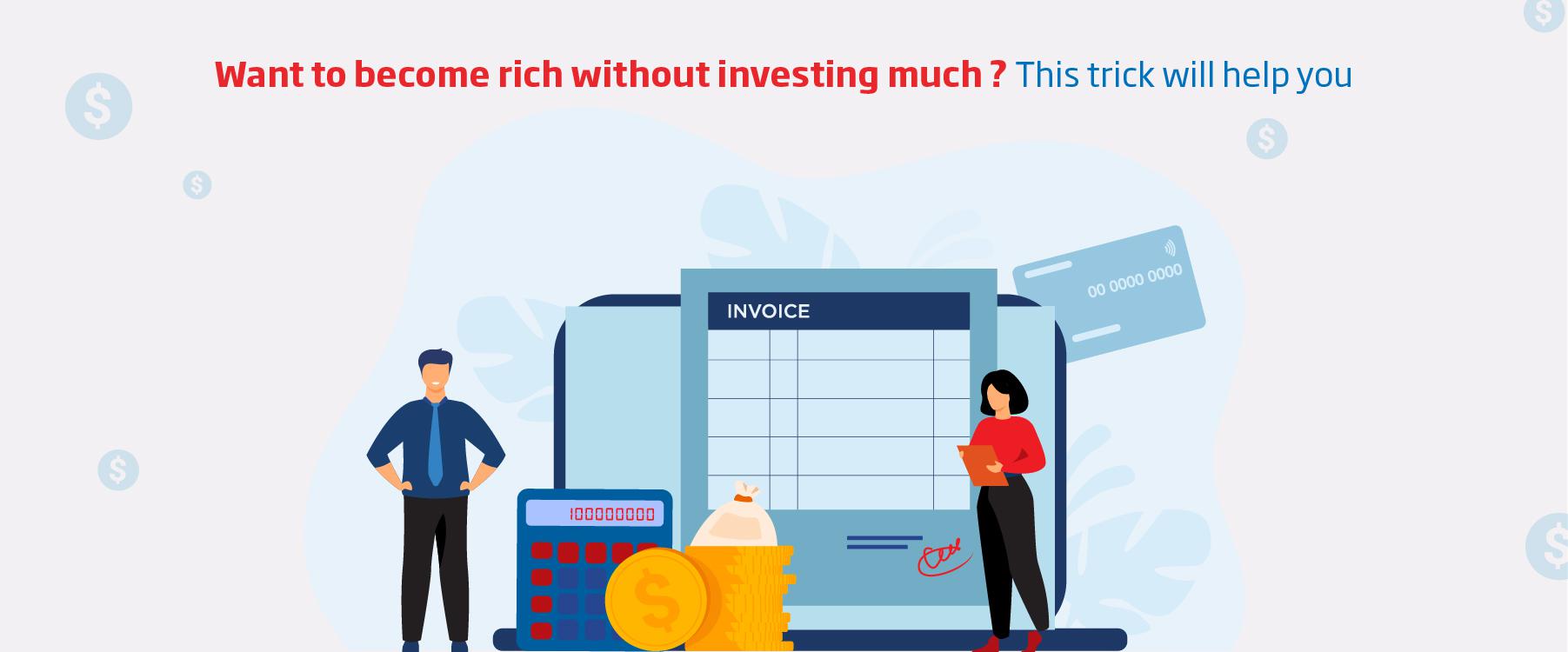What do you want to do?
Want to become rich without investing much? This trick will help you.

Table of Content
Most investors tend to gravitate towards stock market investments for long-term wealth creation. Not only are they riskier, but they also require a lot of research and periodic assessments. This can end up draining you of your time and other resources, which you could have otherwise utilized towards other productive tasks. But wait, what if we told you that there was another way to get rich without having to do any of this? Intrigued? Continue reading to know more about the unique concept of compounding.
The power of compounding
Before we take a look at how compounding helps you get rich, let's first try to understand what it really is.
When you invest in a scheme that offers you a particular rate of return, and if you reinvest the returns that you earned back into the same scheme, you end up earning "interest on interest". This is what experts call "compounding".
When it comes to compounding, time is of the essence. For instance, when compounding is allowed to work its magic for a sufficiently long period of time, it can lead to an exponentially meteoric rise in your investment value. To put it simply, time is what helps create money here.
One of the major advantages of this way of wealth creation is that it requires the least amount of interference. All that you need to do is invest your money in an investment option that uses compounding, sit back and relax, and watch as compounding magically multiplies your returns. You don't even have to monitor its performance periodically - it is that good.
But then, how is compounding capable of doing so much? And how does it work? These are some of the questions that we'll be answering in the next segment with a couple of examples.
Compounding: An example
Let's take up the case of two friends - Prakash and Rashmi. Both of them plan to invest Rs. 5,00,000 for 10 years in a scheme that gives them a return of around 8% per annum. Here's the catch, though. Prakash's investment option doesn't utilize the power of compounding, but Rashmi's does. And so, the return on investment that Rashmi gets to earn every year is reinvested back into the same scheme. As for Prakash, his return on investment gets paid out to him at the end of every year.
Here's what their investments look like at the end of 10 years.
Prakash |
Rashmi |
|
The amount of investment |
Rs. 5,00,000 |
Rs. 5,00,000 |
The rate of return |
8% per annum |
8% per annum |
The period of investment |
10 years |
10 years |
The frequency of compounding |
- |
Yearly |
Final investment amount |
Rs. 9,00,000 |
Rs. 10,79,462 |
Although both of them invested the same amount in almost the same scheme, Rashmi earned Rs. 1,79,462 more than Prakash without having to do anything extra. This was made possible only due to the power of compounding. Rashmi was able to more than double her initial investment within just a period of 10 years. Impressive, isn't it?
Remember how you saw that time is of the essence with respect to compounding? Here's a practical example that proves how time is money, as far as compounding is concerned.
Let's take up another situation involving a different set of friends - Megha and Rakesh. Here, Megha decides to invest Rs. 3,00,000 in a compounding scheme that offers a return of 8% for a period of 20 years. Rakesh, on the other hand, starts a bit late and as a result is able to invest in the same scheme for only 14 years. However, to compensate for the late start, Rakesh decides to invest Rs. 4,50,000 instead. Here's how their investments look at the end of 20 years.
Megha |
Rakesh |
|
The amount of investment |
Rs. 3,00,000 |
Rs. 4,50,000 |
The rate of return |
8% per annum |
8% per annum |
The period of investment |
20 years |
14 years |
The frequency of compounding |
Yearly |
Yearly |
Final investment amount |
Rs. 13,98,287 |
Rs. 13,21,737 |
Although Rakesh invested around Rs. 1.5 lakh more than Megha, he still fell short of Rs. 76,550. This was simply due to the fact that Rakesh started late and so, had less time on his hands. The example conclusively proves that by simply starting early, you can build an exponentially larger corpus than when you start late.
Conclusion
There are many investment options in India that use the power of compounding. You can also complement these investments with other options like savings plans, which provide guaranteed payouts as well as a life cover. For instance, HDFC Life Sanchay Plus is a savings plan that you can customize to suit your needs. It offers benefit options that you can choose from, like long-term income, guaranteed* maturity payouts, and lifelong income, among others.
*Provided all due premiums have been paid and the policy is in force.
ARN:ED/11/20/21328
 Term Plan Articles
Term Plan Articles
 Investment Articles
Investment Articles
 Savings Articles
Savings Articles
 Life Insurance Articles
Life Insurance Articles
 Tax Articles
Tax Articles
 Retirement Articles
Retirement Articles
 ULIP Articles
ULIP Articles
Subscribe to get the latest articles directly in your inbox
 Health Plans Articles
Health Plans Articles
 Child Plans Articles
Child Plans Articles
 Popular Calculators
Popular Calculators
 Insurance Advisor Articles
Insurance Advisor Articles
Here's all you should know about life insurance.
We help you to make informed insurance decisions for a lifetime.
HDFC Life
Reviewed by Life Insurance Experts
HDFC LIFE IS A TRUSTED LIFE INSURANCE PARTNER
We at HDFC Life are committed to offer innovative products and services that enable individuals live a ‘Life of Pride’. For over two decades we have been providing life insurance plans - protection, pension, savings, investment, annuity and health.

Popular Searches
- Term Insurance Calculator
- Investment Plans
- Investment Calculator
- Investment for Beginners
- Best Short Term Investments
- Best Long Term Investments
- 5 year Investment Plan
- savings plan
- ulip plan
- retirement plans
- health plans
- child insurance plans
- group insurance plans
- income tax calculator
- bmi calculator
- compound interest calculator
- income tax slab
- Income Tax Return
- what is term insurance
- Ulip vs SIP
- tax planning for salaried employees
- HRA Calculator
- Annuity From NPS
- Retirement Calculator
- Pension Calculator
- nps vs ppf
- short term investment plans
- safest investment options
- one time investment plans
- types of investments
- best investment options
- best investment options in India
- Term Insurance for Housewife
- Money Back Policy
- 1 Crore Term Insurance
- life Insurance policy
- NPS Calculator
- Savings Calculator
- life Insurance
- Gratuity Calculator
- Zero Cost Term Insurance
- critical illness insurance
- itc claim
- deductions under 80C
- section 80d
- Whole Life Insurance
- benefits of term insurance
- types of life insurance
- types of term insurance
- Benefits of Life Insurance
- Endowment Policy
- Term Insurance for NRI
- Term Insurance for Women
- Term Insurance for Self Employed
- Benefits of Health Insurance
- Health Insurance for Senior Citizens
- Health Insurance for NRI
- Best Term Insurance Plan for 1 Crore
- personal accident insurance
- Annuity Calculator
- Life Insurance Calculator
- Term Insurance Comparison
- Digital Life Insurance
- Child Education Planner
- GST on Term Insurance
- Term insurance for Diabetics
- Term Insurance for Doctors
- Term Insurance for Overweight
- Term Insurance for Below Poverty Line

